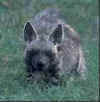 ���
���  ���
���  ���
���  ���
��� 
The Beast of G�vaudan
One of the most perplexing cryptozoological
mysteries of all time, the Beast of G�vaudan was a cow-sized, wolf-like monster which
terrorized the district of G�vaudan (Loz�re), France, from 1764 until 1767.
This tiny province, in the Margeride Mountains of south-central France, first became
aware of the Beast in June, 1764.� That month, a young woman was attacked by a large,
wolf-like monster in the For�t de Mer�oire near Langogne.� She was one of the few
people who survived an encounter with la B�te, a creature which was, peculiarly,
referred to in the feminine.
In October of that year, two hunters came across the Beast and shot at it from close
range.� The Beast was hit a total of four times, but it seemed relatively untouched.
� A Capt. Duhamel, who commanded nearly 60 soldiers, began his own hunt for La B�te,
and on several occasions wounded it--but it was still not killed.
In 1765, King Louis XV himself sent an experienced wolf-hunter named Denneval to G�vaudan
to kill the Beast.� Before Denneval himself managed to track down the Beast, a man
named de la Chaumette saw the Beast near his home, near St.-Chely.� He and his two
brothers went out to a pasture in hopes of killing the Beast.� They shot it twice,
but it still didn't die.
In June, 1765, Denneval gave up his hunt.� The previous month, King Louis sent out
his chief gun-carrier, Antoine de Beauterne.� On September 21, he launched a hunt in
the B�al Ravine, near Pommier.� He shot what he believed was the Beast.� It was
an extremely large wolf, 6 feet long.� De Beauterne's kill was preserved up until
this century in the Museum of Natural History in Paris.
But the killings still continued.� In the summer of 1767, hundreds of peasants made
pilgrimages to Notre-Dame de Beaulieu Cathedral near Mount Chauvet to pray for deliverance
from the creature, which was widely believed to be either punishment sent by God, or
possibly a loup-garou (werewolf).� One of the peasants who went to the cathedral was
a hermit named Jean Chastel.� He had his rifle and three bullets blessed.
On June 19, 1767, an area noble organized a huge hunt, with more than 300 participants.
Chastel, at the Sogne d'Aubert, waited for the Beast to appear, praying all the while.
� When it appeared, he shot it.� Finally, it died.
What was the Beast? The French peasants of the area believed it to be some sort of demon,
but an English account from about the same time said the Beast was most likely a member of
"a new species", which they said was a hybrid of tiger and hyena.� Learned
men believed it to have been a wolverine, a bear, or even a baboon.
Appendix: The carcass of De Beauterne's kill was found in the
basement of the National Museum of Natural History in Paris.� It was identified as a
wolf, after which time the body was supposedly discarded due to poor condition.� It
was recently rediscovered by zoologist Franz Jullien, who has identified it as a striped
hyena (Hyaena hyaena), normally native to Africa.
Left to right - four contemporary sketches of the Beast; a striped hyena: the true face of the Beast?
For full citations, see my article "The Beast of G�vaudan and Other Maulers".